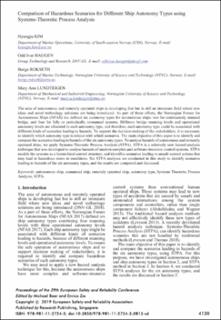Comparison of Hazardous Scenarios for Different Ship Autonomy Types using Systems-Theoretic Process Analysis
Chapter
Published version
Permanent lenke
https://hdl.handle.net/11250/2680568Utgivelsesdato
2019Metadata
Vis full innførselSamlinger
Originalversjon
Kim, H., Haugen, O. I., Rokseth, B., & Lundteigen, M. A. (2019). Comparison of Hazardous Scenarios for Different Ship Autonomy Types using Systems-Theoretic Process Analysis. I M. Beer & E. Zio (Red.), Proceedings of the 29th European Safety and Reliability Conference. Research Publishing. https://doi.org/10.3850/978-981-11-2724-3_0813-cdSammendrag
The area of autonomous and remotely operated ships is developing fast but is still an immature field where new ideas and novel technology solutions are being introduced. As part of these efforts, the Norwegian Forum for Autonomous Ships (NFAS) has defined six autonomy types for autonomous ships: two for continuously manned bridge, and four for fully or periodically unmanned systems. Different bridge manning levels and operational autonomy levels are allocated to each autonomy type, and therefore, each autonomy type could be associated with different kinds of scenarios leading to hazards. To support the decision making of the stakeholders, it is necessary to identify which autonomy type is related with which scenarios. The main objective of this paper is to identify and compare the scenarios leading to hazards of the six autonomy types. To analyse hazards of autonomous and remotely operated ships, we apply Systems-Theoretic Process Analysis (STPA). STPA is a relatively new hazard analysis technique that was developed to analyse hazards of modern complex and software-intensive control systems. STPA models the systems as a hierarchical control structure, and identifies scenarios leading to unsafe control actions that may lead to hazardous states or conditions. Six STPA analyses are conducted in this study to identify scenarios leading to hazards of the six autonomy types, and the results are compared and discussed.
